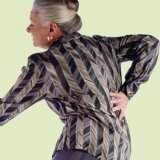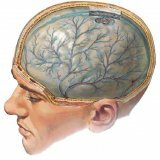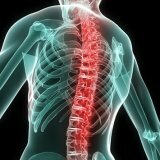Osteoporosis in women in menopause

Osteoporosis is a chronic disease characterized by a decrease in bone tissue. The patient's risk of fractures increases, as the bone density decreases as a result of the disease, which leads to an increased risk of fractures. Every third woman with menopause suffers from this disease.
The main cause of bone density reduction is the age-related changes in the body. It was noted that the greatest density of bone tissue is observed at the age of twenty-five years, which changes little to thirty years, after which the density begins to decrease. This is most expressed in females. In women aged seventy-seventy-five years, bone loss can reach up to forty-five percent. Much less is expressed in males, because thanks to androgens( male sex hormone), bone mass is initially more dense than in women.
Osteoporosis in women during menopause.
Osteoporosis in women in the climacteric has its own individual characteristics. So, in this period hormonal changes occur in the body, which leads to a more rapid development of osteoporosis. In the initial period of menopause in 25% of women, bone density decreases in the range of ten to fifteen percent per year, over two to three years. The next twenty-five percent - from one to two percent, and the second half of the weaker sex is not observed such changes.
Surgery worsens - removing the ovaries or uterus, as well as taking medications, resulting in a dramatic decrease in the number of sex hormones in women, and this activates the cells that "eat" the bone, called in medicine by osteoclasts, the negative effect of which is manifested in the withdrawal of calcium fromBones, and osteoblasts - "building" cells - lower their activity. Because of the lack of sexual hormones in women from the intestine, calcium absorbed with food is worse absorbed.
A imbalance of hormones in both sexes leads to the development of the disease in question, which is most progressive when the adrenal and thyroid gland function is disrupted.
Many studies have been conducted, which resulted in the following pattern: in high and slender women, susceptibility to osteoporosis and its consequences is manifested much more often than in full-fledged women with a dense physique. This is due to the fact that with increasing body weight, in order to withstand its weight, bones have throughout the existence of gaining weight and increase the density of bone tissue. An important role of physique is also attributed to the fact that women with a dense physique have a higher level of sex hormones than that of "slivers".
The human lifestyle also has an effect on the density of bone tissue. In sedentary people, the loss of bone tissue is more progressive than in the leading active lifestyle. A real person who is bedridden, on average, loses about one percent of bone mass per week. With the resumption of physical activity, the state of bones gradually improves. From this we can conclude: people who engage in sports and lead an active lifestyle, less susceptibility to osteoporosis than people inactive. At present, due to the desire to improve comfortable living conditions and employment by intellectual labor, and not physical, leads to the fact that osteoporosis is characterized as a "silent" epidemic, especially in large settlements and cities.
Women in the menopause period have certain factors that increase the risk of osteoporosis.
- Age is more than sixty years old.
- Partial resection, as well as removal of the ovaries or uterus, regardless of the age at which surgery was performed. Women who underwent these surgeries need life-long hormonal therapy.
- Predisposition at the genetic level is externally slender women with low weight, thin bones and light skin, leading a passive lifestyle. Increases the risk of hereditary disease with osteoporosis along the mother's line. If there is data on the disease with osteoporosis, then the probability of the disease in the climacteric period is extremely high.
- Untimely onset of menopause, earlier than forty, fifty-five years, significantly increases the risk of osteoporosis.
- Large children with four or more children breastfeeding, as pregnancy and breastfeeding, even in the absence of a genetic predisposition, lead to a reduction in bone mass in any case.
- Low-fracture bone fractures over the age of forty, obtained from a fall from the height of their growth.
- Harmful habits: excessive consumption of alcoholic beverages, coffee, smoking.
- Passive way of life, expressed in low mobility.
- Taking medications related to the group of corticosteroids: methylprednisolone, hydrocortisone, prednisolone. Increased doses of thyroid hormones, immunosuppressors, large doses of radiation therapy. Tetracycline series of antibiotics, antsida, used to reduce the acidity of gastric juice with long-term use of the above drugs.
Prevention of osteoporosis and its treatment during menopause.
Osteoporosis is a chronic disease, the prevention of which must be started as early as possible, by strengthening its bones. It is recommended to take calcium preparations together with magnesium and vitamin D, which helps to assimilate calcium. Diets have the opposite effect on bone density, full nutrition is needed.
Good prevention of osteoporosis, as has been repeatedly noted in this article, is the conduct of an active lifestyle, exercise, swimming, dancing, daily walks in the fresh air, an indispensable disposal of bad habits.
Is osteoporosis treatable?
Osteoporosis is not cure, so complex therapy is needed to improve the patient's well-being. The best option is to take miokaltsik and ostalona( biophosphonates), with the combined use of calcium and vitamin D. But the treatment should be prescribed by the attending physician after examination of the bone tissue.



